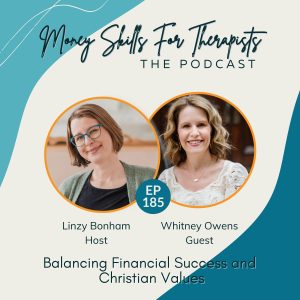[00:00:00] Linzy: Hello and welcome back to another Feelings and Finances episode of the Money Skills for Therapist podcast. These are our short and sweet Friday episodes where I answer questions from you, the lovely therapists and health practitioners who make up our money skills for therapists community. Today’s question is from Allison, and here’s Allison’s question.
[00:00:20] Allison: Hi, my name is Alison. I own a multi practitioner clinic, and my question is how do I gain better mastery over cashflow for my clinic and work with what seemed to be unusual fears around my cash flow spreadsheet? Thanks.
[00:00:44] Linzy: Thank you so much for your question, Allison, and it is lovely to hear from you again. We have connected in the past, so yes. How do you manage your cash flow? So what I’m hearing is you have a spreadsheet already that you have some unusual fears about. I’m not sure what those fears are, so I’m going to talk about what a working cashflow system
[00:01:05] looks like. When we have a larger business, like a group practice where you do have so many more variables of money coming and going, cashflow becomes much more important than it is for a smaller practice. So we do need to have reliable tools that allow us to see how that flow is working. You know, what is the money coming in?
[00:01:26] What is the money coming out? what jobs has it been doing historically? What do we need it to do? And there’s two ways that I suggest that you keep your finger on the pulse of cash flow. These are both things that we teach in Money Skills for Group Practice Owners, and that we have the tools in Money Skills for Group Practice Owners because they’re absolutely foundational,
[00:01:45] Allison, for you being able to have your finger on the pulse of what is happening with your cash flow. So the first one is a weekly metrics tool. You want to have a weekly tool… I’m using the word tool here, almost a little bit generously. ’cause really it can be a very, very simple spreadsheet.
[00:02:01] It doesn’t have to be complicated at all. But you want to be looking at how your money is flowing weekly as well as monthly and annually. So we’re going to talk about weekly first. In a weekly metrics sheet, and this applies to all level of practice,we want to have the most important numbers, those numbers that we really need to keep track of right on the surface so that we have a light touch relationship with them each week.
[00:02:25] And I say light touch because ideally with your finances, as a financial leader, and you know, as a group practice owner, Allison, you are the financial leader of your practice, ideally you get to the point with your finances where it doesn’t become this like heavy or arduous task to look at the money or figure out where it is.
[00:02:42] It becomes this like nice light habit that you do every week to just check in, see what’s going on, make sure everything looks great, make sure everything looks normal. Move on with your week. So, those weekly metrics, some of the numbers that you’re going to want to be looking at is how much money is in each of your key bank accounts?
[00:02:58] Maybe you have one bank account. Maybe you use a system like Profit First, where you have multiple bank accounts. What is the bank account balances at a given point in time? I do my weekly metrics every Monday morning. So every Monday morning my team and I start the weekwith a weekly metrics meeting where each of us collects our own metrics.
[00:03:14] I’m collecting all the financial metrics, but also my team is collecting different marketing metrics. We have many more marketing metrics than, you know, therapy businesses tend to because of the type of business that we are being in the online space. So, every week you want to be putting together the data that you want to have right front and center.
[00:03:31] So it’s going to be those bank account balances. It’s going to be how much money did we bill last week, or how much money did we collect last week? If you’re using insurance, there might be a gap between those two numbers, so you might want to record both of those numbers. How many sessions did we bill for? How much money actually came in last week?
[00:03:47] But you’re also going to want to be looking at your clinicians’ performance. So how many sessions did people see last week? How many inquiries did we have last week? How many of those turned into consults or first sessions, whatever your system is? How many of those first sessions turned into second sessions?
[00:04:02] You want to be looking at all the numbers that you’ve identified are important from your cashflow perspective. So there’s the movement of money, but also just like one level up from that cashflow, from the movement of money, is what is happening in your practice? How much, you know, service is being delivered that turns into the cash that is cash flow.
[00:04:20] So that’s where I’m talking both here about looking at your financial snapshot, but also your delivery snapshot. ‘ cause that shows you how much money is going to be coming down the pipe because of the services that were delivered. And then you could also be looking at your marketing metrics. But for the sake of cash flow, we’re just going to focus on these weekly numbers.
[00:04:37] That is going to give you a sense of what is normal, where numbers need to be. It’s going to give you a sense of, okay, when I run a payroll, how much do the numbers drop that week? And as you, again, start to have that light touch relationship with those numbers, you’re going to have a sense of like, okay, this week is a payroll week.
[00:04:53] When I look in the payroll account, I see a number that. I know it’s going to cover our typical payroll, so I don’t have to worry about that. You are going to start to know what’s normal without having to even analyze it in a really conscious way. You’re going to have a feel for what’s normal and what’s not, which also lets you catch issues.
[00:05:08] So for instance, if you generally see each week that your business collects, let’s say $10,000 a week, generally comes in the door and then when Monday you go to do your metrics and you see it was only 5,000. That’s like, cause for curiosity. It’s a chance for you to look and see what happened.
[00:05:23] Did an insurance company not pay us like they usually do? Were claims not submitted? Did my clinicians not bill? Did we not do a bunch of sessions last week? Was somebody sick? Were there a bunch of cancellations? It gives you information that you can then investigate to see what is happening that has interrupted
[00:05:41] the flow of cash that we need, and then you can take immediate action to do something about it. Rather than realizing it a month later, you can see there’s something happening. We didn’t get, you know, our, our normal insurance checks. Oh, this insurance company hasn’t paid us, which they usually would. What’s going on?
[00:05:56] And then you can immediately start to deal with issues before they start to snowball into much bigger problems. So those are your weekly metrics that you can do on a weekly metrics tool, which is just a simple spreadsheet. Your monthly and annual metrics are where you really start to get the big picture flow of the cash, and that is where you’re going to track where the money went so that you can see what is normal in terms of where money is going.
[00:06:22] So, the spreadsheet that we use in Money Skills for Group Practice Owners is called the Big Picture Tool. It has a monthly tab and it also has an annual view where you can see, okay, in January this much money came in the door. This is what we paid out to our team, which is this percentage.This is what we paid for our operating expenses, which is this percentage. And you’re going to start to understand and have a sense of what do those percentages need to look like? What is sustainable for your business, what isn’t? And this is more of a retrospective, right? We’re capturing what has happened, but this is where you can start to have a more zoomed out picture of like, okay, we are
[00:06:56] spending more on staff than we can afford, what can we do about that? And this is where in money skills group practice owners, we have the tools to start to see, okay, what if? What if, you know, your clinician saw one more client each? What if everybody raised their fees? What if you lowered some operating expenses somewhere else?
[00:07:10] Like what is going to make the numbers work? But that monthly picture lets you see what is normal, what is sustainable, what needs to change. And then we also have an annual view, which lets you see big picture between all the ups and downs of the month to month, how have the numbers shaken out over time?
[00:07:25] And that lets you see the overall big sustainability. That’s not cashflow, it’s not looking forward, it’s looking backwards, but it helps you see how the changes that you’re making, have made a larger impact in the business over time. So there’s that weekly, monthly, annual view. My suggestion is having, again, like a weekly relationship with those weekly numbers. Monthly, you would do those numbers after you get your reports from your bookkeeper, and then the 12 month numbers you would also do, when you get the report from your bookkeeper to look at in the last 12 months, what has happened in the business.
[00:07:55] Now, in terms of your fears about your spreadsheet, I’m not sure exactly what those are. But sometimes fears that I can see about spreadsheets is that the numbers, there’s a fear that the numbers are not reliable, that they don’t make sense, that they’re not real. So whenever we’re developing a tool and developing our skills with a tool, it is important to really take our time with it.
[00:08:13] To make sure that the numbers are real. We never want to be working with numbers that aren’t real. It happens sometimes. You know, there ends up being glitches in our formulas, we add a line and a formula doesn’t update so things aren’t getting added together properly. So this is really, Allison, where I find having that grounded presence with your numbers really helps because then you can look at the numbers, and you can be with them and see, does this make sense?
[00:08:37] You know, my numbers are saying that we collected 40,000 in October, but only 25,000 in November. Is that true? Does that make sense? And then you can go investigate, right? This number says that we spent, you know, 80% of our expenses on staff, and then 40% of our expenses on operating expenses, but that we didn’t lose money.
[00:08:56] That doesn’t make sense. There’s something wrong here. And you can investigate. That attitude of curiosity gets you so far with finances because it lets you investigate, tweak, fix. And it lets you trust yourself, right? Because when you can trust yourself to be with a notice, and be able to fix, then you can start to play with numbers.
[00:09:22] You can start to investigate your numbers in new, different ways because you know that you can trust yourself to notice if something is off. But we can only notice if something is off, if we actually have developed the familiarity with the numbers, and the literacy around the tools that we’re using, and the confidence to be able to tell if there’s something off and they’re not working.
[00:09:41] And we do that through practice. So, I’m wishing you much groundedness and curiosity, as you are working with your cashflow numbers, Allison. And really encourage you to yeah, start to be with those numbers on that weekly, monthly, and annual picture basis is going to help you become really literate in understanding what is happening with your numbers and identifying where you might need to make changes to make your group practice more sustainable.
[00:10:08] If you like Allison, have a question you would like me to answer on one of these Feelings and Finances episodes, all you need to do is click on the link in the show notes.It will bring you over to our podcast page where we have a little recording button.
[00:10:20] Just push record, share your name, a little bit of context and share your question, and I would be happy to answer it on an upcoming episode of Feelings and Finances. Thank you so much for joining me today.









